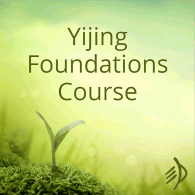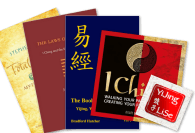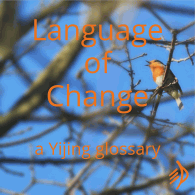36, Brightness Hiding
With Hexagrams 13 and 22, and maybe even 30, I could build up a picture of how li inside projected its light through the outer trigram, bringing awareness and enlightenment to it. When I get to Hexagram 36, with light inside earth, this becomes altogether trickier. It’s called, at least in some translations, Brightness Hiding, because (and this blog post comes to you, as they so often do, from the Department of the Blithering Obvious) light can’t shine through the earth. This is why it’s dark at night time.
The main story of the hexagram, that of Prince Ji, is also of light hidden. He keeps his light under a bushel, disguising his intelligence and understanding, to stay out of trouble. As a rule, the trigram earth outside offers service, acceptance and protection – but Prince Ji is in no position to offer much service. There isn’t anything very useful he can do. In practice, for him, bringing light to earth or intelligent awareness to service and responsiveness means being unavailable – or at best, being very discriminating indeed about his availability.
Light inside earth is wounded because it cannot shine. Fire inside earth might be banked up – maybe for charcoal burning, maybe just to keep the embers warm enough to rekindle in the morning. While I can’t see any trace of the story of banking a fire in the lines of Hexagram 36, the simpler idea of protecting the fire with earth is something we know as part of our experience of the hexagram.
It turns out I was already writing about li as inner trigram some 13 years ago, and perhaps what I came up with then is an adequate description of Jizi:
It’s night-time; perhaps the eyes are closed, and the light of awareness is earthed up like a charcoal-burner’s fire. You might be hiding the extent of your insight (often what 36 seems to be advising); you might be seeing in an earth-like way: open, receptive, not doing anything to change what you see, just being aware.
All this only goes to show what we already knew: that spinning formulas from trigram characteristics is all very well, but always secondary to the characteristics of the individual trigrams and their unique relationship. So is there any use at all here for the more abstract formulation that inner li enlivens and enlightens the outer trigram? Fire within in Hexagram 22 lit up the mountain and brought awareness and intelligent relativism to human standards; fire inside the lake in Hexagram 49 will bring clarity to human interactions; and in Hexagram 55, casting light on thunder, it will mean enlightened initiative. So is there some kind of enlightened responsiveness in 36?
I think there is, but it took the Image authors to see it:
‘Brightness enters the earth’s centre. Brightness Hidden.
A noble one, overseeing the crowds, uses darkness and light.’
or
‘…using the darkness to shine in.’
Rutt, Zhouyi
or
‘…It is by keeping it dark that brilliance is had.’
R.J. Lynn, Classic of Changes
or
‘He veils his light yet still shines.’
Wilhelm/Baynes
or
‘…using darkness, but with intelligence.’
Bradford Hatcher
Different translators add their own flavour to the text, and with it their own interpretation of what the noble one does here, but the original says simply that he makes use of dark and light.
We can see, of course, that light belongs to the inner trigram and dark to the outer. But the combination is also something like enlivened and enlightened acceptance and protection. At least, this is a traditional interpretation of the image. Cheng Yi said, in effect, that too much light impairs your vision because it damages your tolerance and acceptance of people. Wang Bi also said that too much light would be counterproductive and one should keep one’s brilliance suppressed so as not to put people off. (I love Wilhelm’s warning against ‘dragging [people] censoriously into the light.’)
So perhaps too much light would create a hostile reaction, or too much light would be too lacking in earth’s quality of unlimited acceptance. In practice, the two go together. If you show someone too much of your brilliant insight all at once, they may well react with hostility, not feeling accepted or understood. So it’s better to use both darkness and light, which in effect means adding some understanding to your acceptance, adding some li to your kun – and vice versa – recognising that not everyone is going to be quite as fully enlightened as you are all at once.
Not that Hexagram 36 always means perfect understanding and enlightened acceptance. (My own experience with 36, especially as relating hexagram, is that it can indicate I am being notably dim.) The Image is not a prediction, but an ideal; the ‘formula’ of inner light enlivening and bringing enlightenment to an outer trigram works, but more as an aspiration than an immediate reality.
37, People in the Home
‘Injury on the outside naturally means turning back towards the home, and so People in the Home follows.’
Hexagram 37, the Sequence of Hexagrams
From wounding to refuge – but the only difference between Brightness Hiding and People in the Home is the outer trigram, changed from earth to wind/wood. The light that was hidden or wounded has become – in the picture the Image authors saw – a fire strong enough to generate a draught:
‘Wind comes forth originally from fire. People in the Home.
Hexagram 37, the Image
A noble one’s words have substance and her actions are consistent.’
Wind on the outside means growth and development – often, carrying through the work of the inner trigram, unfolding it as a process over time and spreading its influence. In Hexagram 37, it translates inner awareness into continuous action in the world; it gives light a new way to spread and create change.
You can feel the hot air rising from the fire in this one – but thinking of xun as wood, I also always picture a hearth fire under a roof, with its light flickering over wooden walls and rafters.
The trigram change encapsulates the difference between the two hexagrams. The difference between Jizi and the people in the home isn’t that he stays in place – so do they (‘people in the home means inside’, says the Zagua) – but that his light is covered over and goes unseen: his influence is stifled. The noble one of 37 no longer needs to use darkness with light: her words can have substance and her actions consistency, like wind filled with fire and light. The people in the home aren’t confined to their four walls – not even the women of ancient China, who went out to new homes when they married. A home is an inner light that shines out.
The Confucian ideal is of a home whose harmonious inner light spreads throughout society, with the whole culture following from that. I can certainly see, in these trigrams, a picture of an honest, dependable individual whose actions reveal a strong inner light – one that might well have its origins in a warm home life.
And overall, the hexagram reminds me of staying in my grandparents’ house as a child in winter. It was many centuries old, timber framed with some wattle-and-daub construction. Grannie – my father’s mother – came downstairs at the crack of dawn each morning to sweep out and relight the fire that was the only source of heat in the place, and warmth from that centre would spread through the house. But it also spread through my father and into my childhood – and through his sister’s kindness into the home I have now, which is her house. (And that reminds me: I need to get the chimneys swept before winter.)
‘People in the Home.
Hexagram 37, the Oracle
A woman’s constancy is fruitful.’










precioso ????????